Shabu Shabu is a Japanese-style hot pot where meat and vegetables are cooked in a flavorful kombu dashi broth. Everyone at the table participates in communal cooking and enjoys the ingredients with different dipping sauces. It‘s intimate yet casual and a whole lot of fun! {Vegetarian options included}
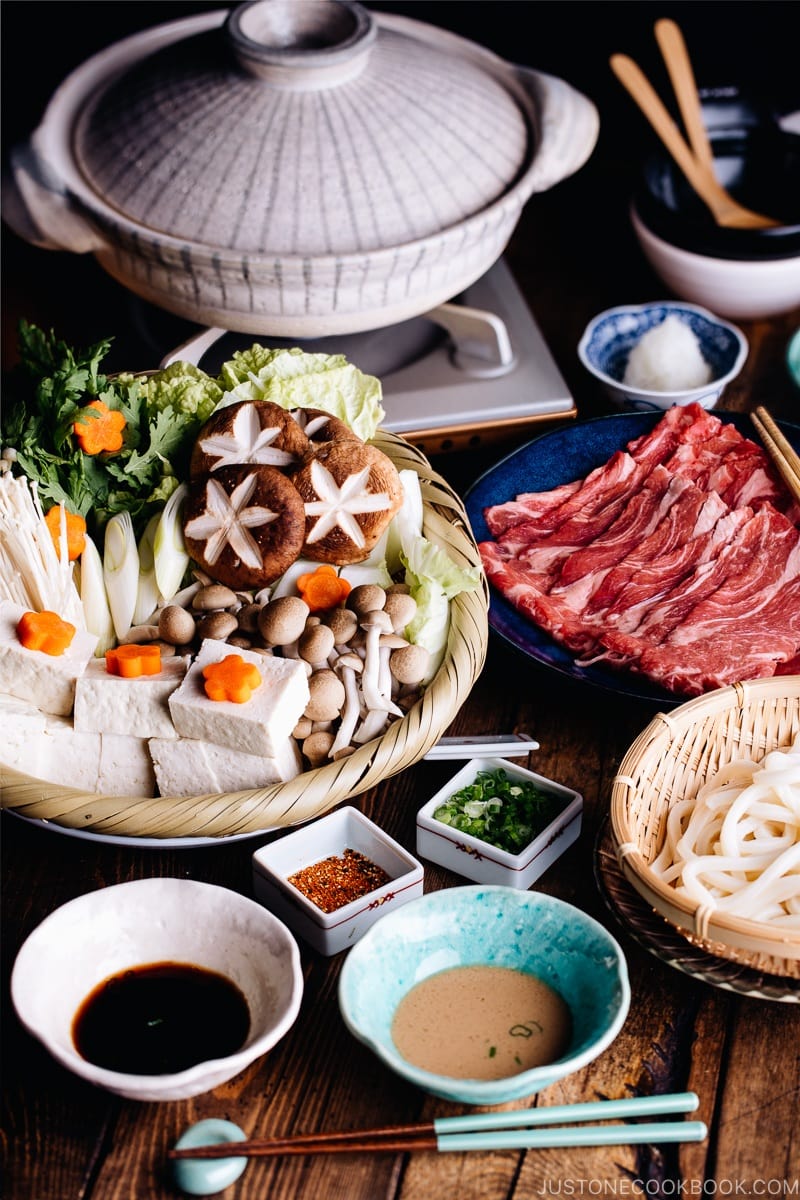
What are some of your ultimate comfort foods that are celebratory yet easy enough to make? In my book, it has to be hot pot! There are many versions of hot pot dishes in Japan, and if you’re wondering where to start, I’d recommend Shabu Shabu (しゃぶしゃぶ).
Not only is it the perfect warming meal to get you through cold days, but it’s also low-effort and great for a get-together. Now, let’s gather your family and friends and shabu shabu!
Table of Contents
What is Shabu Shabu?
Shabu Shabu is one of Japan’s most famous hot pot dishes, along with Sukiyaki. The name “shabu shabu” is Japanese onomatopoeia. It came from the sound when you stir the vegetables and meat with your chopsticks and ‘swish swish’ in the hot pot.
It makes a super fun meal where everyone sits around the table, cooks together, and enjoys chatting while eating, much like fondue! A communal dining experience that not only inspires good appetites but also brings people closer together.
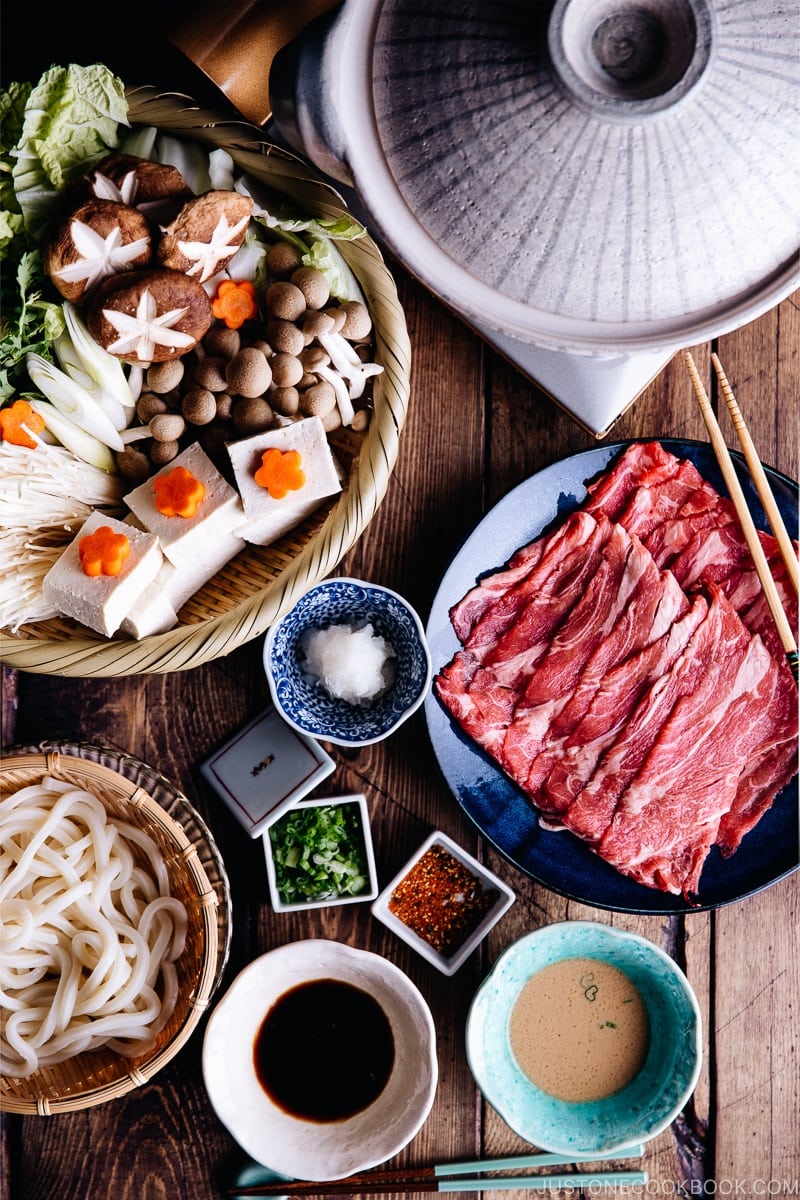
Shabu Shabu Ingredients
Shabu Shabu is so easy to make! You’ll need the following ingredients:
- Kombu dashi for the hot pot stock
- Vegetables, mushrooms, tofu, and udon noodles
- Thinly sliced beef/pork
- Dipping sauces
Ingredients are pretty simple and you can get them from a Japanese supermarket or the majority of Asian grocery stores. Let’s talk more about them below.
1. Kombu Dashi
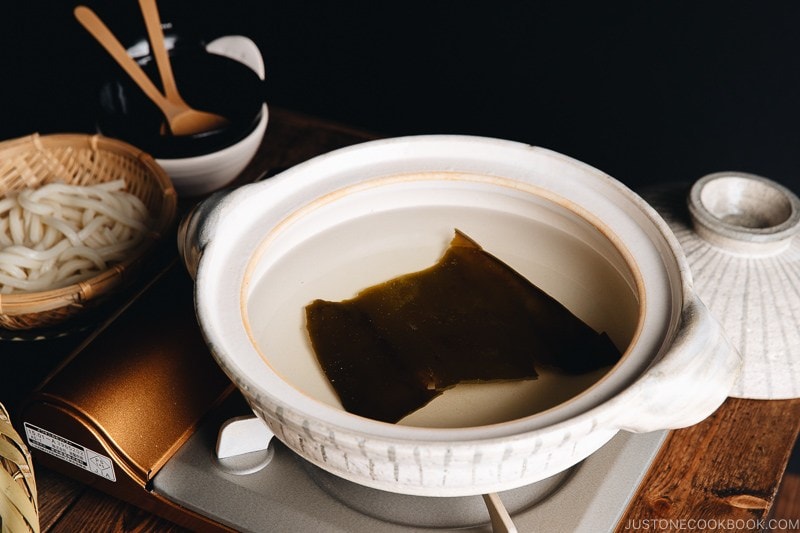
There are many different types of dashi (Japanese soup stock), but for shabu shabu, we use kombu dashi made with kombu (kelp). It is vegetarian and really easy to make. You can simply drop a piece of kombu in a pot of water and let it steep. That’s it!
2. Vegetables, Mushrooms, Tofu, and Udon
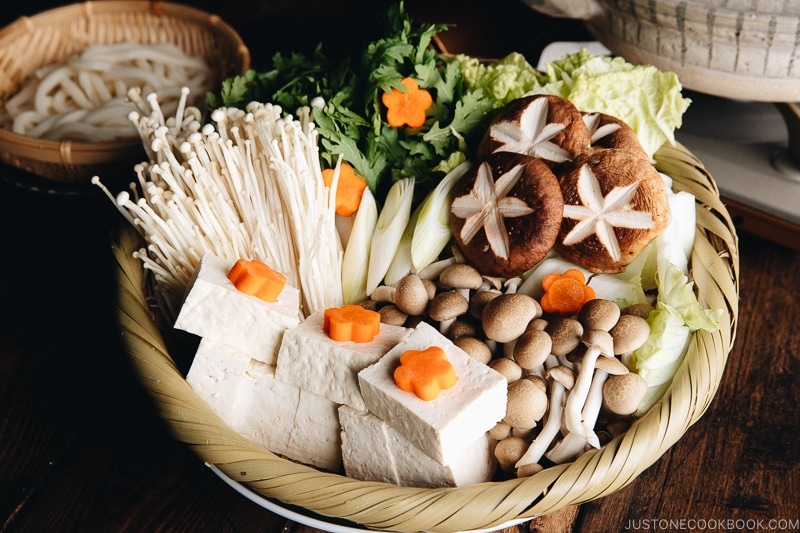
The most commonly used vegetables for shabu shabu are napa cabbage, chrysanthemum greens (shungiku), long green onion (negi), and carrot. You can also add other vegetables like cabbage, broccoli, zucchini, carrots, other leafy Asian greens, sweet corn (cut in sections), etc.
However, it’s worth a trip to your nearest Asian grocery store for harder-to-find ingredients like shungiku and long green onion, which are usually available at Chinese and Korean grocery stores. As for napa cabbage, you may have luck finding it at major grocery stores like Walmart, Target, Whole Foods, etc.
The Japanese mushrooms are often used in this recipe include shiitake, enoki, and shimeji mushrooms. You can also use other types of mushrooms, such as button mushrooms, to enjoy different textures.
We always add medium/medium-firm tofu to shabu shabu. You should be able to find it at your local grocery store these days.
Vegetarians? These are all you need to make shabu shabu for vegetarians. For a greater variety of ingredients, feel free to use a mixture of tofu, such as grilled tofu or tofu puffs.
Udon noodle is optional but we often add them for some substance. When we finish all the ingredients, we add some udon noodles to the soup and enjoy them at the end.
3. Thinly Sliced Beef or Pork
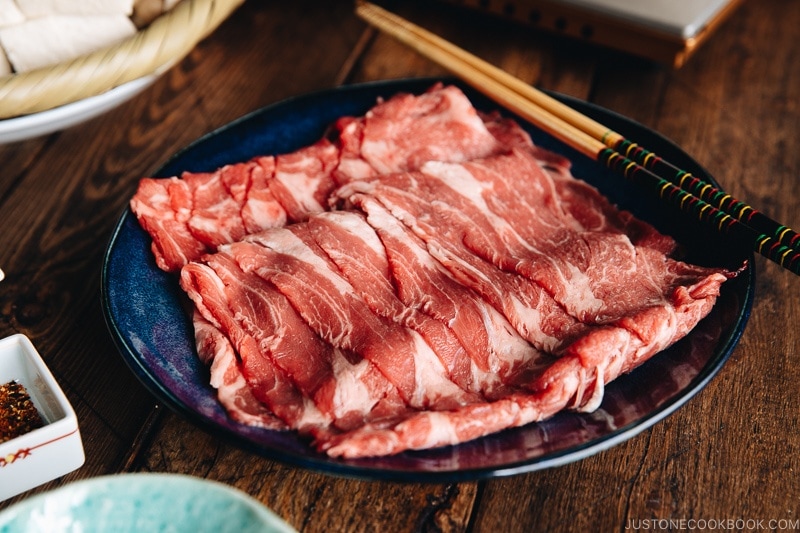
The best part of shabu shabu is enjoying these thinly sliced marbled meats, which we cook briefly to add flavor to the broth. Typically, beef and pork are the most commonly served meats, but you can occasionally find chicken, seafood, and sometimes lamb being offered in some restaurants.
The most noticeable difference in having shabu shabu outside of Japan is the quality of meat. It can be difficult to source the same quality meat in the US without paying a high price. Supermarkets in Japan offer great quality beef at a regular price, but we make it work!
You can buy thinly sliced “shabu shabu” beef (or pork) from a Japanese or Asian supermarket near you. I highly recommend visiting a well-stocked Korean grocery store as their meet quality is pretty good.
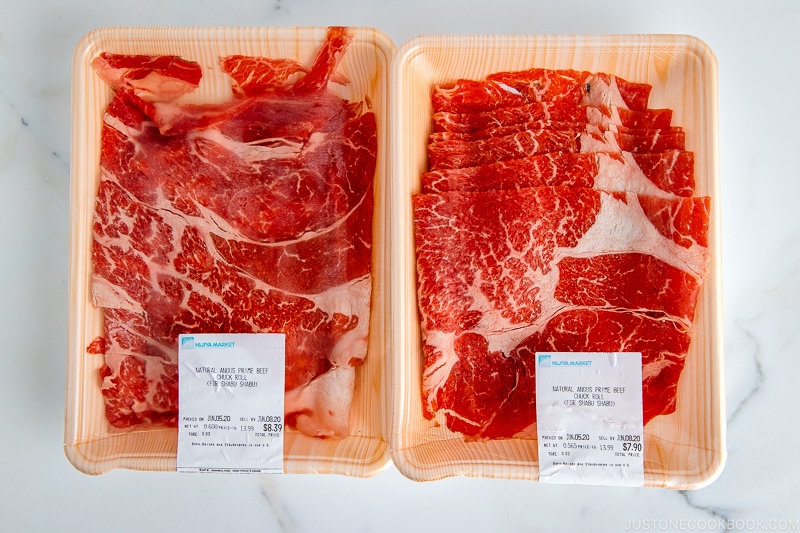
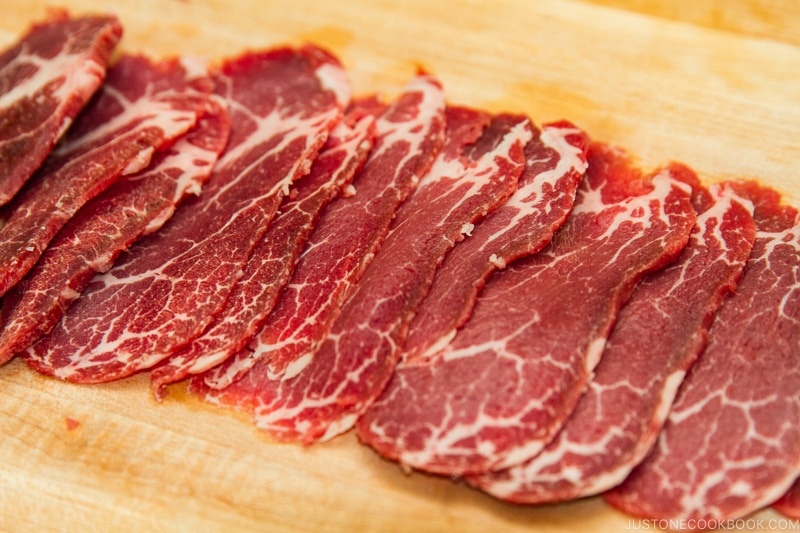
If there is no Asian grocery store near you, you probably won’t be able to find thinly sliced meat in your local grocery store. Therefore, you get good quality meat and slice the meat yourself with a sharp knife. It’s effortless to do, and here’s the tutorial.
4. Dipping Sauces
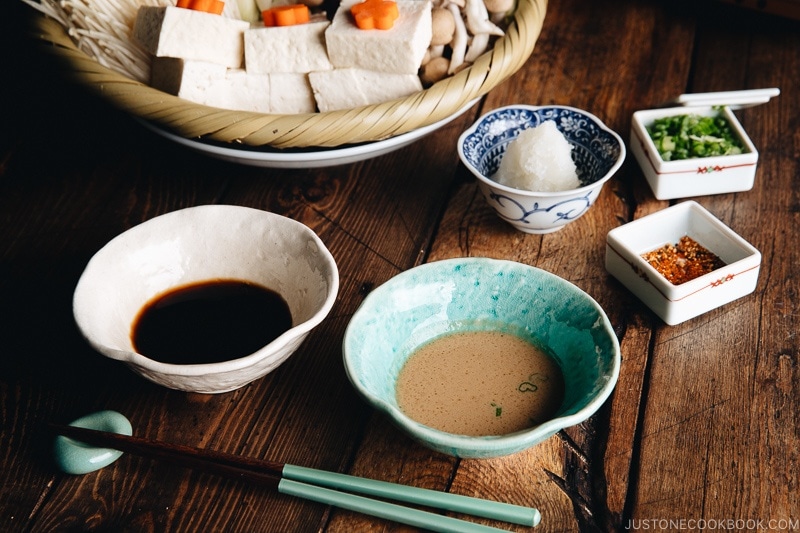
For shabu shabu, we typically provide each person with their own dipping sauces—ponzu sauce and sesame sauce. You can purchase these in a bottle at a Japanese/Asian grocery store or Amazon (you can get these ponzu and sesame sauce). I like making my Homemade Ponzu Sauce and Homemade Sesame Sauce recipes.
Don’t forget to prepare grated daikon, chopped green onions, and shichimi togarashi so you can add them to the ponzu sauce when you eat.
How to Make the Best Shabu Shabu
First, let’s set up the table. Your pot should be placed on a portable gas stove (and don’t forget to get gas canisters) in the center of the table. Here I use the earthenware pot called donabe (土鍋). Inside is a simple yet umami-packed kombu dashi. We arrange the uncooked ingredients on two large plates—one for thinly sliced well-marbled beef (and/or pork) and the other for vegetables, mushrooms, and tofu (with optional udon noodles).
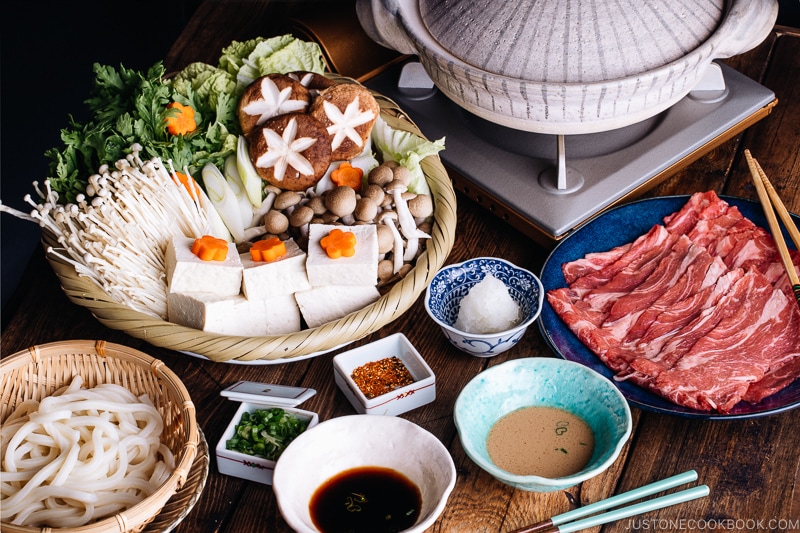
In addition to the ingredient platters, we provide each person with their own dipping sauces. I recommend providing each person a shallow bowl so you can let the food cool a little before eating.
Once everyone is seated, start cooking dense vegetables (white parts of napa cabbage, long green onion, stems of chrysantmemum greens). I usually set a 10 minute timer and close the lid. Once boiling, reduce the heat to low and keep it simmer.
After 10 minutes, add softer, leafy vegetables. When they are done cooking, pick up one slice of meat with the communal long cooking chopsticks and gently stir it in the broth for a few seconds. Paper-thin slices of meat take only a few seconds to cook. When the meat is done cooking, transfer it to your own bowl of dipping sauce. Pick a person who cooks the meat for everyone. This way, everyone gets meat at the same time.
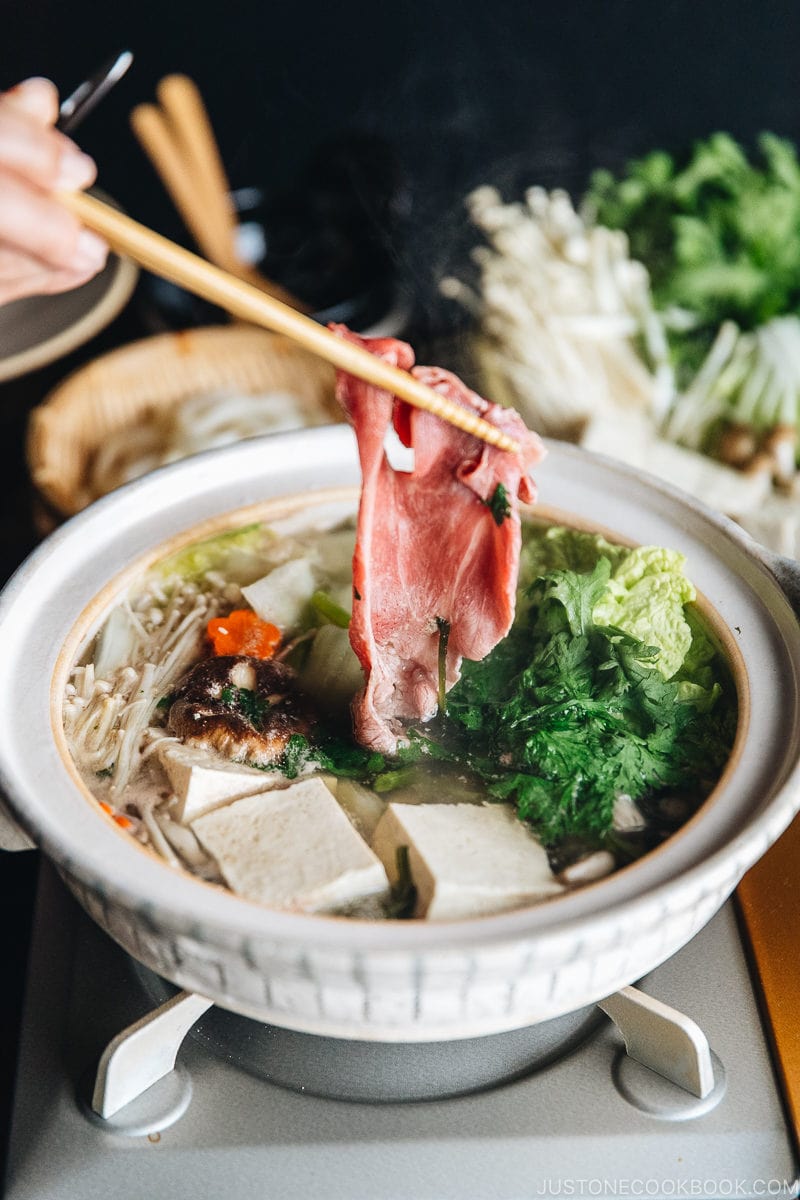
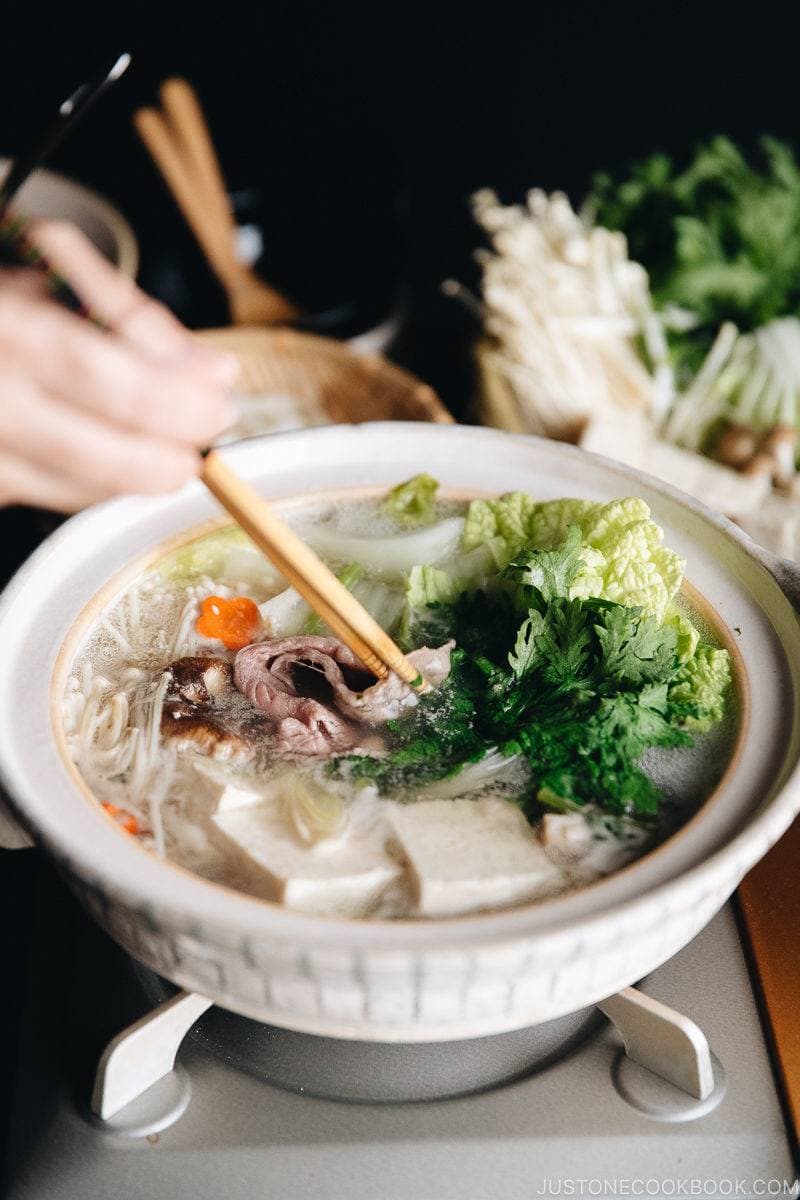
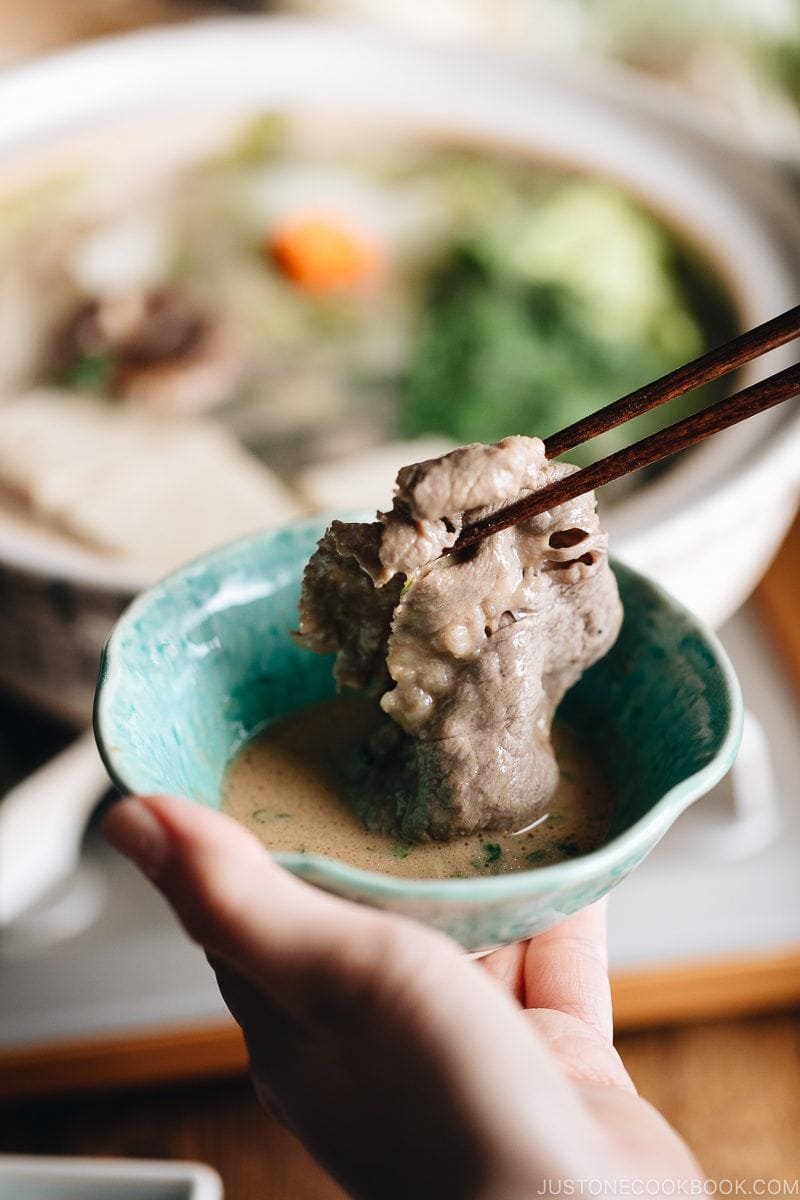
You can dip cooked vegetables, tofu, and meat in sesame or ponzu sauce. I love meat in sesame sauce and vegetables and tofu in ponzu sauce.
You can continue to cook while you eat, using a set of communal chopsticks for cooking ingredients and serving. While cooking, skim scum and foam from the surface with a fine mesh skimmer to keep the stock clean.
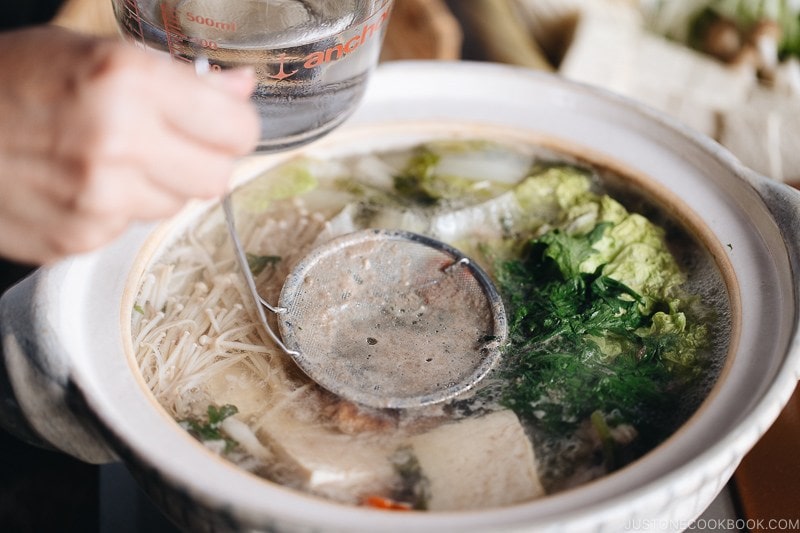
Once you‘ve cooked all the ingredients and removed them from the hot pot, cook udon noodles in the remaining broth and enjoy.
If you dine at a shabu shabu restaurant, the staff will get you started by cooking a few ingredients first. Don’t hesitate to ask if you are unsure how to proceed. If you’re at home cooking up the hot pot, I hope this post will guide you through everything you need to know to enjoy your first shabu shabu experience.
Watch Shabu Shabu Recipe Video
Watch the video below to see how you prepare the ingredients and cook them at the table. Have fun making shabu shabu with your family and friends!
Use Donabe (Japanese Clay Pot) for Hot Pot
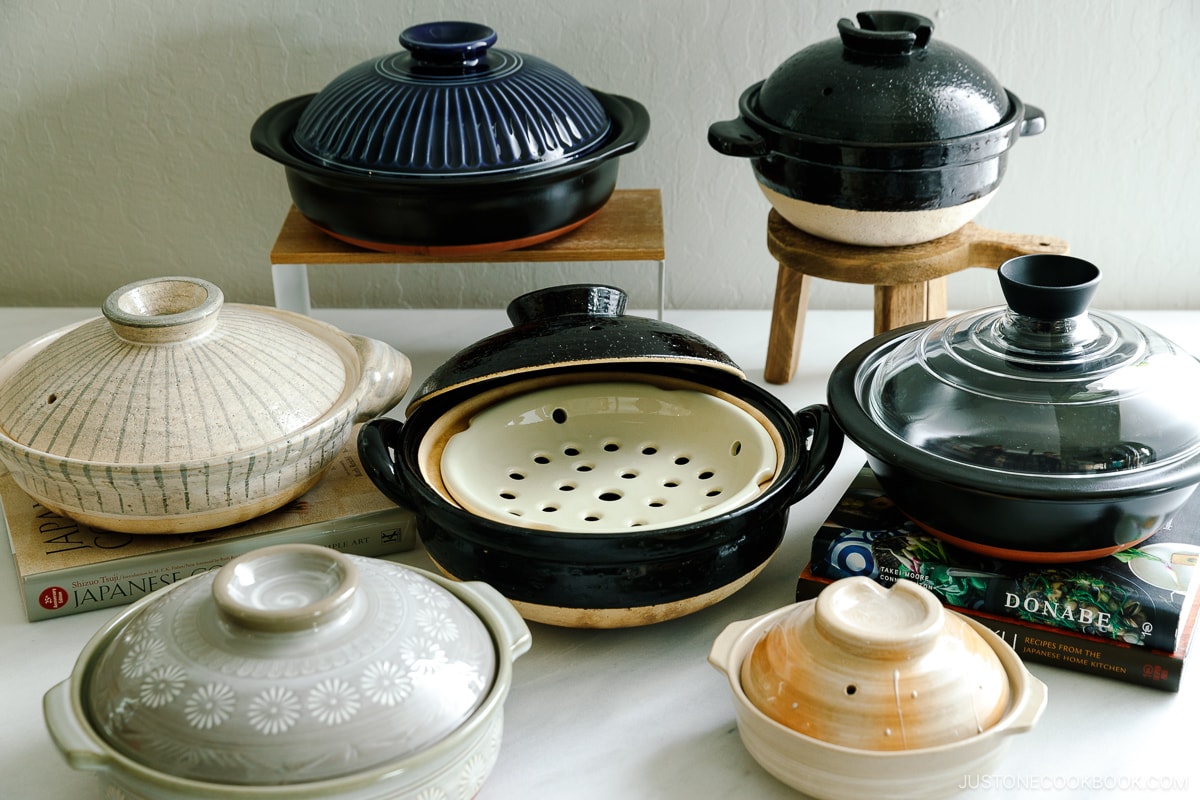
Shabu Shabu is typically cooked in a donabe (土鍋), an earthenware pot, on a portable gas stove with a gas canister at the table. You can also use a heavy-bottomed pot such as a Dutch oven. This traditional clay pot distributes heat and retains heat well, and it makes beautiful serveware for shabu shabu.
If you are shopping for a donabe, please see my tips on how to choose the best donabe for you. Before you use your donabe for the first time, please learn how to season and care for your donabe.
Healthy Hot Pot Recipes
As a busy mom, I make shabu shabu during the holidays and all year round. It’s a quick, easy, and healthy meal. I love that I don’t have to cook before dinner time. All I need to do is to cut the ingredients and let everyone cook dinner together at the table.
Since we cook all the ingredients in broth, no oil is used in the hot pot. It’s a very low-fat meal and a great way to incorporate many vegetables. Happy swishing and enjoy shabu shabu all year round!
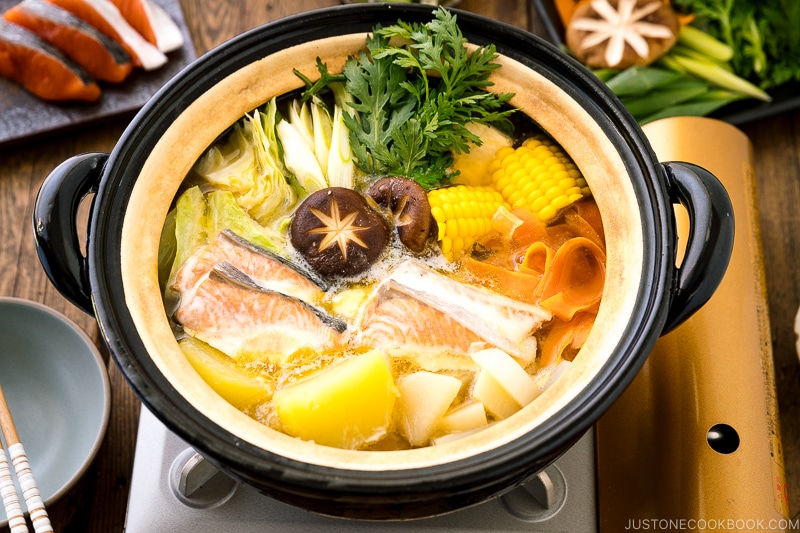
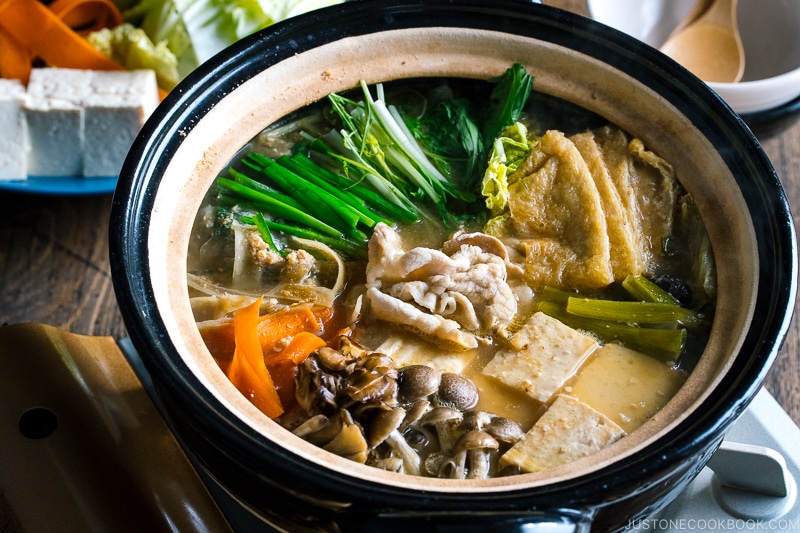
To learn about Japanese Hot Pot, check out Nabemono: A Guide to Japanese Hot Pot, and here are some of my favorite hot pot recipes:
- Sesame Miso Hot Pot (Goma Miso Nabe)
- Hokkaido Salmon Hot Pot (Ishikari Nabe)
- Monk Fish Hot Pot (Anko Nabe)
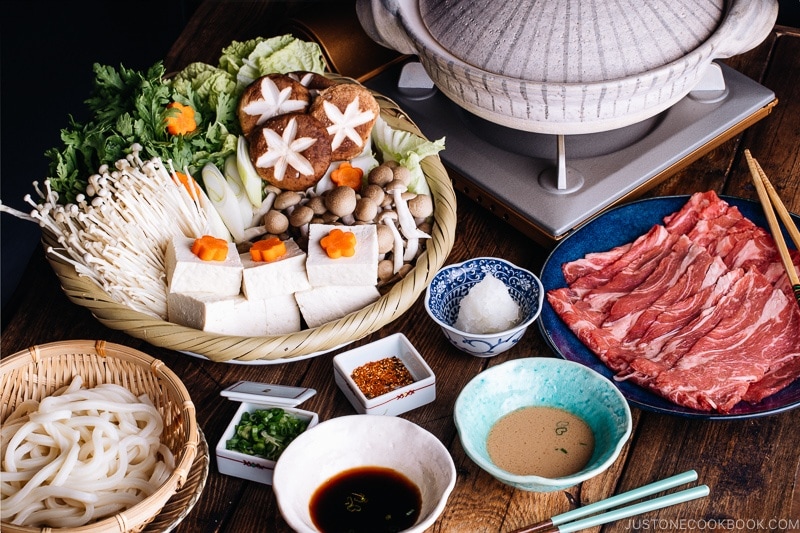
Wish to learn more about Japanese cooking? Sign up for our free newsletter to receive cooking tips & recipe updates! And stay in touch with me on Facebook, Pinterest, YouTube, and Instagram.
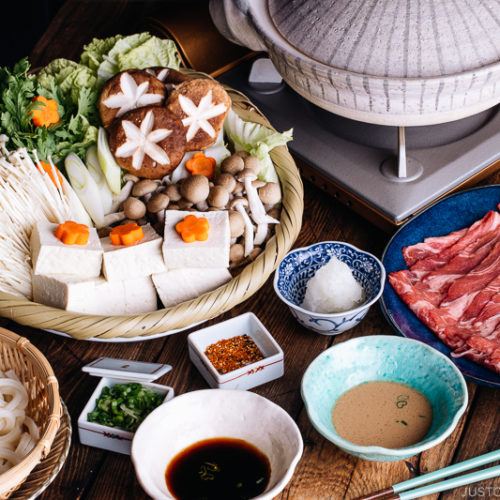
Shabu Shabu
Video
Ingredients
- 1 piece kombu (dried kelp) (use 1 piece per donabe; each piece 10 g, 3 x 3 inches, 7.5 x 7.5 cm)
- water
- 1 serving udon noodles (8.8 oz, 250 g frozen or parboiled udon noodles; 3 oz, 90 g dry udon noodles)
- 8 leaves napa cabbage (12 oz, 340 g)
- ½ bunch shungiku (chrysanthemum greens) (4 oz, 113 g)
- 1 Tokyo negi (naga negi; long green onion) (4 oz, 113 g; or use the white part of 1 leek or 2 green onions)
- 1 package enoki mushrooms (7 oz, 200 g)
- 1 package shimeji mushrooms (3.5 oz, 100 g)
- 4 shiitake mushrooms (2.3 oz, 65 g)
- 2 inches carrot (2.3 oz, 65 g)
- 1 package medium-firm tofu (momen dofu) (14 oz, 396 g)
- 1 lb thinly sliced beef (chuck or ribeye) (4–5 oz, 113–140 g per serving)
For Serving
- 2 inches daikon radish (5 oz, 143 g)
- 2 green onions/scallions (0.9 oz, 25 g)
- shichimi togarashi (Japanese seven spice)
- sesame dipping sauce (or make my Homemade Sesame Sauce)
- ponzu (or make my Homemade Ponzu Sauce)
Instructions
Before You Start…
- You can make my Homemade Ponzu Sauce and Homemade Sesame Sauce from scratch ahead of time. You can also purchase these sauces at Japanese grocery stores.

- Gather all the ingredients.

To Prepare the Broth
- Fill 1 large donabe clay pot (or Dutch oven or any large pot) two-thirds full of water. Add 1 piece kombu (dried kelp) and soak in the water for at least 30 minutes. Meanwhile, you can prepare the other ingredients. The right image shows the kombu dashi broth after 30 minutes. Note: Use 1 piece of kombu per large donabe. If you‘re doubling this recipe, use two donabe and put 1 piece of kombu in each pot.

To Prepare the Ingredients
- Prepare the udon noodles according to the instructions. Reheat 1 serving udon noodles (still frozen) in boiling water for 1 minute. Transfer the noodles to iced water to stop the cooking and drain well. Place on a plate and set aside. You‘ll end the meal with the udon course after you‘ve cooked and eaten all the other ingredients.

- Cut 8 leaves napa cabbage into 2-inch (5-cm) pieces, and then cut each piece in half or into thirds.

- Cut ½ bunch shungiku (chrysanthemum greens) into 2-inch (5-cm) pieces.

- We only use the white part of 1 Tokyo negi (naga negi; long green onion) (or the leek or green onions). Cut it diagonally into pieces ½ inch (1.3 cm) thick.

- Rinse 1 package enoki mushrooms and 1 package shimeji mushrooms. Discard the root ends of both mushrooms and separate them into smaller chunks.

- Cut off the stems of 4 shiitake mushrooms and make a decorative cutting on the cap (optional).

- Cut 2 inches carrot into ¼-inch rounds. If you‘d like, you can use a vegetable cutter to create a flower shape.

- Cut 1 package medium-firm tofu (momen dofu) into square pieces about 1 inch (2.5 cm) thick.

- Arrange all the ingredients on a serving platter.

- Peel 2 inches daikon radish and grate it (I use a ceramic grater). Squeeze the grated daikon gently to remove most of the liquid and put it into a small bowl.

- Cut 2 green onions/scallions into thin rounds and put it in a bowl.

- Prepare shichimi togarashi (Japanese seven spice) in a bowl (optional). Lay the thinly sliced beef on a plate.

To Cook the Shabu Shabu
- Set up a portable gas stove at the table and put the donabe on the burner. Place the platters with the ingredients on the table. Give each person their own bowls of ponzu and sesame dipping sauce. I also like to prepare an additional bowl for each person so they can use it to cool the food.

- Bring the broth to a simmer over medium heat. Take out the kombu right before water starts to boil (otherwise, the water will get slimy).

- Add the tofu, tough parts of napa cabbage and shungiku, negi, carrots, and some mushrooms. You don’t have to put all the ingredients in at once; you may cook in batches if you prefer. Cover to cook for 10 minutes.

To Eat the Shabu Shabu
- While you’re waiting for the food to cook, prepare your dipping sauces. Add the grated daikon, shichimi togarashi, and green onion to the ponzu. Add the green onion to the sesame sauce.

- When you‘re ready to eat the meat, pick up a piece of 1 lb thinly sliced beef (chuck or ribeye) with a set of communal chopsticks and stir or “swish“ the meat in the boiling broth. Cook for 20–30 seconds or until the meat is no longer pink; be careful not to overcook it.

- Take out the cooked beef and vegetables from the pot when they are done and dip the food in the ponzu or sesame sauce.

- Add the remaining ingredients to the boiling broth as needed and simmer for a few minutes. Skim off the scum and foam from the surface as you cook. Prepare a fine-mesh skimmer and a 2-cup measuring cup or bowl filled with water at the table so you can easily skim as you cook. The water in the measuring cup will help you clean the skimmer. We want to keep the broth as clean as possible.

- When all the ingredients are cooked, skim the broth one last time to prepare for the udon noodles. Typically, a hot pot meal ends with cooking udon noodles or porridge.

- Add the udon noodles to the pot and reheat for 1–2 minutes. Lightly season the broth with salt and white pepper, if you‘d like (optional).

- Dilute the individual bowls of ponzu sauce with the broth and serve the udon noodles in each bowl.

To Store
- You can keep the leftovers in an airtight container and store in the refrigerator for 3 days or in the freezer for a month.
Nutrition
Editor’s Note: This post was originally published on December 2, 2011. It was updated with a new video and new images in December 2018. It was republished with more helpful content on February 20, 2024.
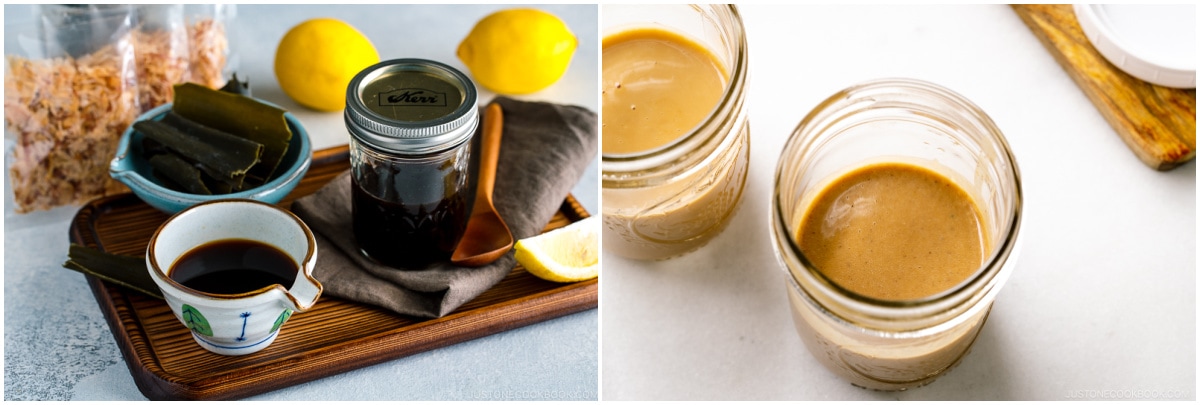
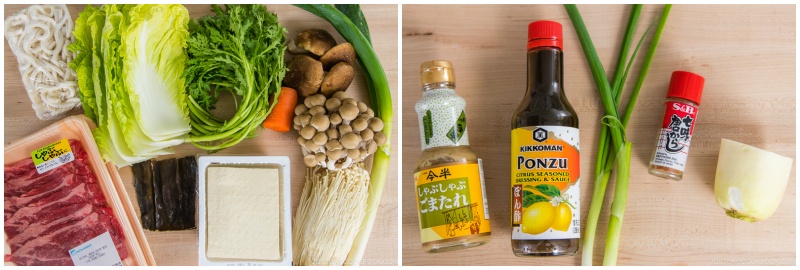
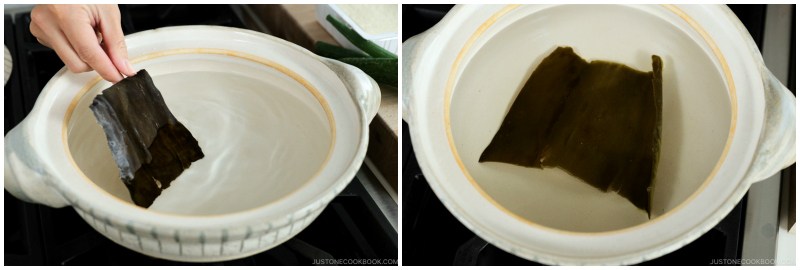

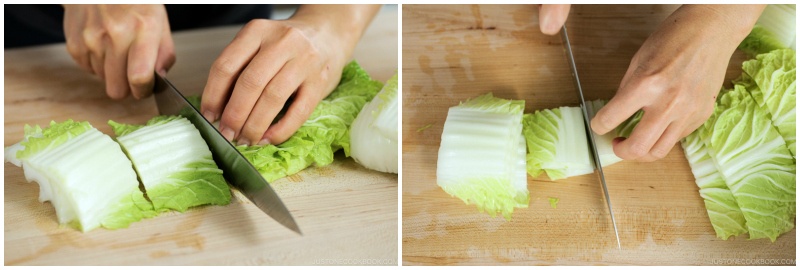
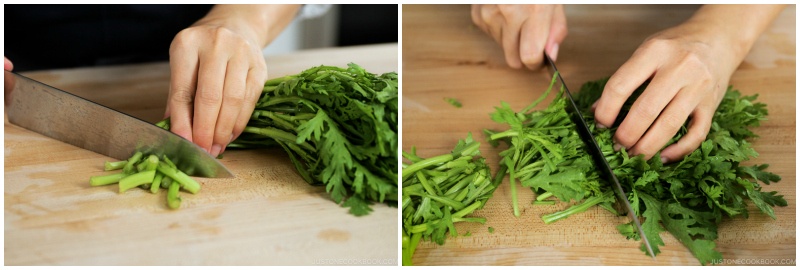
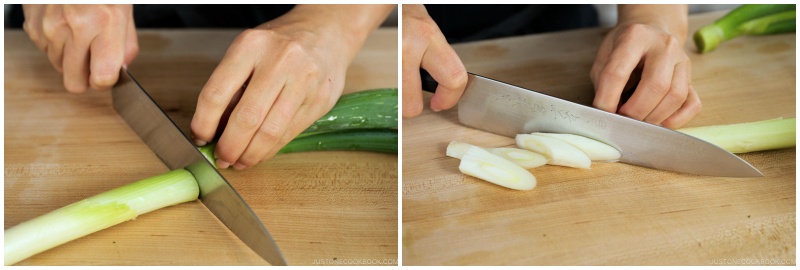



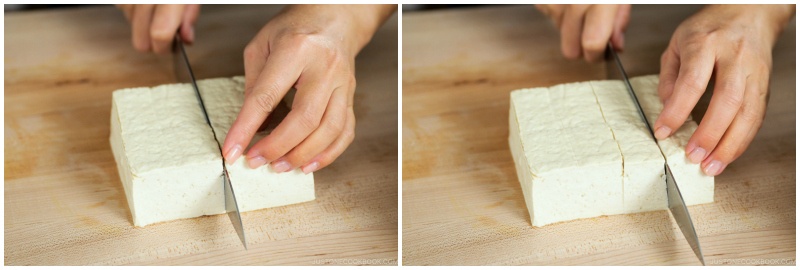
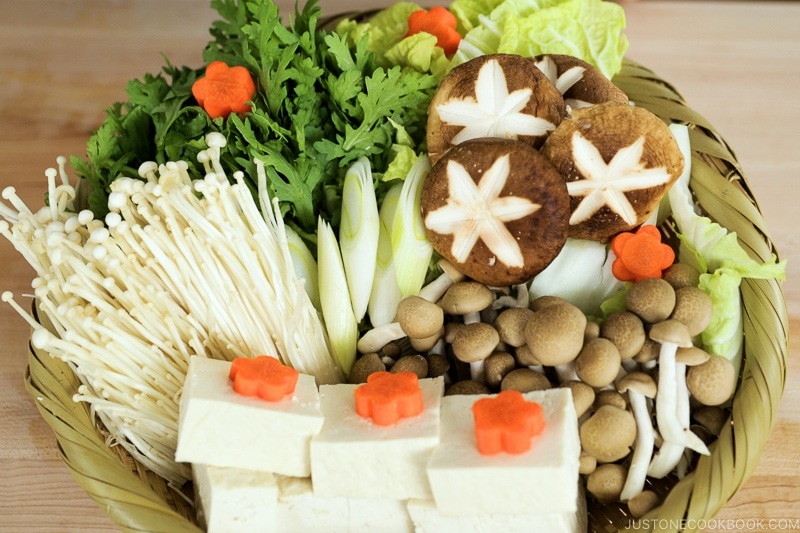
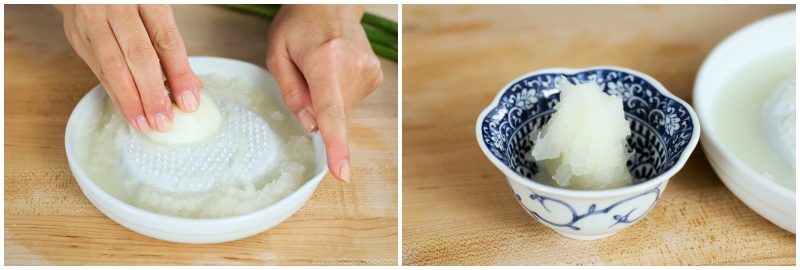
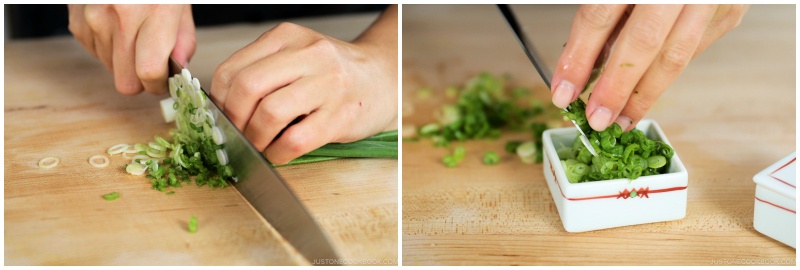
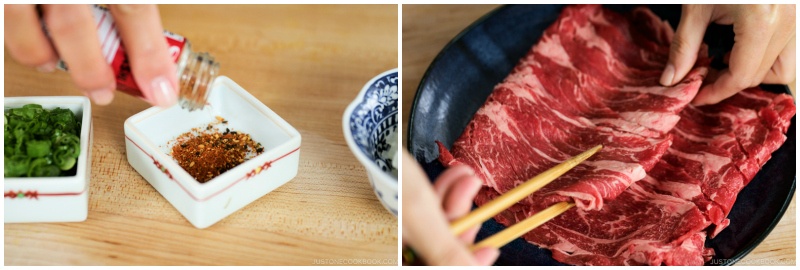
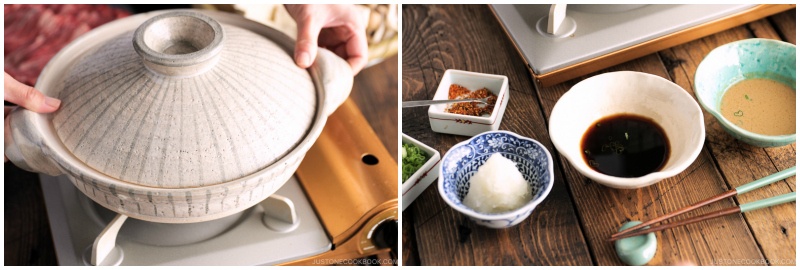
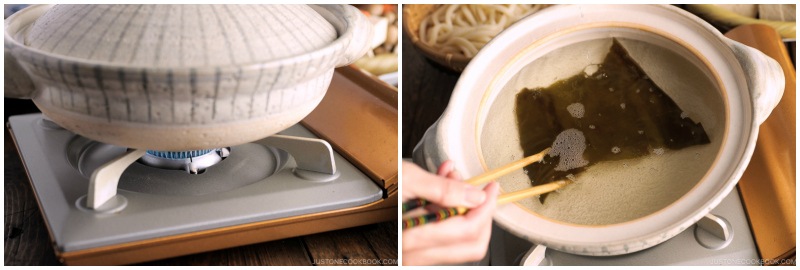
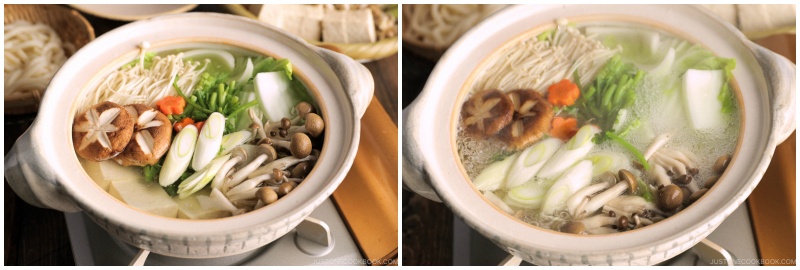

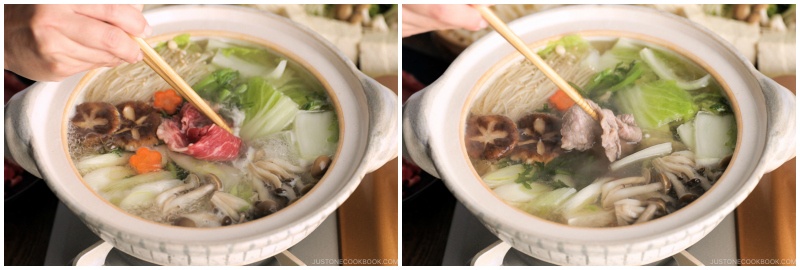
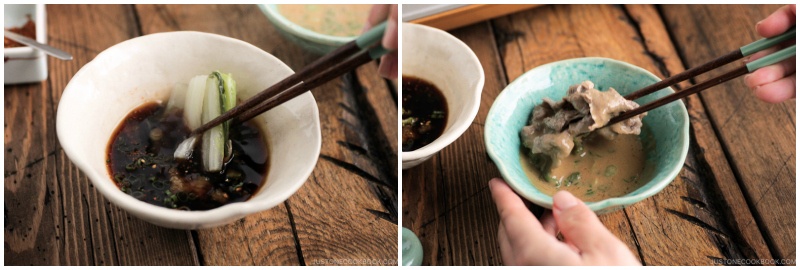
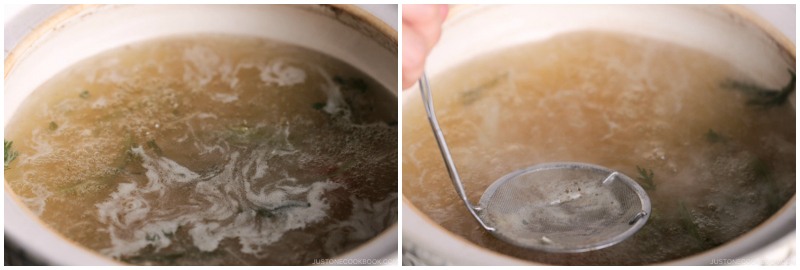













I used to enjoy eating Shabu Shabu in Japan, I followed your recipe exactly and it came out great!! I live in Bay Area like you, as you said there are many Shabu Shabu restaurants in this area, but most are not so great and the few that are good are costly. Its super easy to get thin meat for Shabu Shabu in this area from Japanese markets or Korean markets. I guess hardest thing for people in many parts of US is getting the correct meat for shabu shabu. Guess can slice it yourself, but not so easy. Thanks for yet another great recipe, you have an amazing site. Thanks so much!!
Hi Brad! Thank you so much for reading Nami’s post and trying her recipe!
We are so happy to hear you enjoyed Shabu Shabu.☺️
Yes. Choosing the right meat for Shabu Shabu is critical, and the quality of the meat makes a significant difference. We are really fortunate to have easy access to Japanese and Asian markets in the Bay Area.
Happy Cooking!
Your video is good not only teaches one how to cook but also how to eat. Thanks
Hi Joyce! Aww. Thank you very much for your kind words and comments.
Nami and all of us at JOC are so happy to hear the video on how to eat was helpful.
Thank you for your love and support!
My son loves to make shabu shabu, and even makes his own dipping sauces from scratch.
Hi Lika! Awesome! Thank you for reading Nami’s post and trying her recipe!
It’s very tasty!
Hi, barto! Thank you very much for trying Nami’s recipe and for your kind feedback!
We are glad to hear you enjoyed it!☺️
Costco offers New York Beef Loin thinly sliced for Shabu Shabu.
Hi Carla! Thank you for sharing the information!
Hi Namiko
There is something missing on this page … a hardware section that says more about the table heater you used … have you any suggestions on what to use?
In fact, why not hardware don’t you list utensils and tableware like ingredients?
Hi Patrick! Thank you very much for reading Nami’s post and trying her recipe!
If you are interested in learning about Japanese Hot Pot, would you please check out “Nabemono: A Guide to Japanese Hot Pot” post?
https://www.justonecookbook.com/nabemono-japanese-hot-pot/
This information is also in this post (above the recipe card), and if you click the red writing, it will direct you to the post.
We hope this helps!☺️
I’m going to make it in my electric fondue pot. It’s just an idea
I made this and it was good!! Thanks for sharing the recipe!
Hi Agnes! Awesome! Thank you very much for trying this recipe and for your kind feedback.😊
I’m excited about making this, but I can’t find shungiku (tong ho/garland chrysanthemum) in any of the Asian markets here in Dallas. What can I use as a substitute? Could I use Dandelion Greens or what would you suggest? Thank you!
Hi Rick, Thank you very much for trying this recipe! Dandelion Greens should work. You can also try Mizuna, baby arugula, or Carrot leaves. Since these leaves cook very fast, we recommend adding at the last 2~3 minutes of cooking time. We hope this helps!
Hi, and thank you so much for your recipes and all your work making them accessible to a diverse audience. Would you mind sharing what size donabe you are using in these pictures, for this recipe? It’s hard to decide which one to get from far away, without being able to hold them in your hand and imagine how they would work. Toiro recipes grouped by donabe style go a long way, but I still need more hands-on impressions. Thank you!
Mihaela, Nami is using 4~5 people size Donabe, 12.2 x 11.02 x 6.46 inches. https://www.amazon.com/dp/B004VKTQMI?ref=exp_justonecookbook_dp_vv_d
We hope this helps, and you can soon enjoy many Donabe recipes! Thank you very much for your kind feedback.
Hi – I meant the Toiro donabe with stripes. What size is Nami using for that pot?
Hi Mihaela, Her Donabe is Medium size and ideal for 2~4 people. If you go to the Torio website, Click details, they have dimensions for each product so you can see if it fits your needs.🙂 We hope this helps!
Hi, I am going to try making this for my Japanese husband. I so enjoyed eating this on my trips to Japan!
What pot do you recommend and where to buy?
Thank you,
Janice
Hi Janice, We recommend using Donabe (Pot used in this post – Japanese earthenware pot) made out of special clay, and it’s one of Japan’s oldest cooking utensils. You can purchase at the Japanese or Adian grocery store or online.
https://www.amazon.com/dp/B004VKTQMI?ref=exp_justonecookbook_dp_vv_d
https://toirokitchen.com/
And here is the post link where Nami explained about Donabe. https://www.justonecookbook.com/how-to-season-your-donabe/
You may also use a Dutch oven or any large pot.
We hope this is helpful!🙂
Fantastic recipe – we’ve made it before and will be having it again on Thanksgiving (we had turkey last weekend). It was my kids’ #1 request. This site is my go-to for Japanese cooking, thank you!
Hi Maura! I’m so happy to hear your children enjoy SHabu Shabu! Thank you for your kind feedback. Happy Thanksgiving to you and your family! xoxo
[…] Shabu Shabu […]
[…] Photo: Just One Cookbook […]
[…] the Japanese grocery store I visit, they carry pork belly slices, super thin pork loin slices (for Shabu Shabu), and semi-thin pork loin slices (for Sukiyaki). Same goes with the beef cut. In Japan, there are […]
[…] the Japanese grocery store I visit, they carry pork belly slices, super thin pork loin slices (for Shabu Shabu), and semi-thin pork loin slices (for Sukiyaki). Same goes for the beef cut. In Japan, there are […]